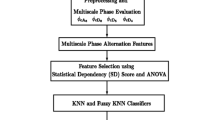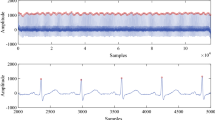Abstract
Cardiodynamicsgram (CDG) has emerged recently as a noninvasive spatiotemporal electrocardiographic method for subtle cardiac dynamics information analysis within electrocardiogram (ECG). This study explored the feasibility of CDG for detecting radiation-induced heart damage (RIHD) in a rat model. A single radiation dose of 40 Gy was delivered to the cardiac apex of female Wistar rats. First, CDG was generated through dynamic modeling of ECG signals using the deterministic learning algorithm. Furthermore, CDG indexes were calculated using the wavelet transform and entropy. In this model, CDG entropy indexes decreased significantly after radiotherapy. The shape of CDG changed significantly after radiotherapy (irregular shape) compared with controls (regular shape). Macrophage and fibrosis in myocardium of rats increased significantly after radiotherapy. CDG changes after radiotherapy were significantly correlated with histopathological changes and occurred significantly earlier than histopathological changes. This study provides an experimental basis for the clinical application of CDG for the early detection of RIHD.
Graphical Abstract







Similar content being viewed by others
Data Availability
The data underlying this article will be made available on reasonable request.
Abbreviations
- CDG:
-
Cardiodynamicsgram
- RIHD:
-
Radiation-induced heart damage
- RT:
-
Radiotherapy
- ECG:
-
Electrocardiogram
- SARRP:
-
Small Animal Radiation Research Platform
- VCG:
-
Vectorcardiography
- IHC:
-
Immunohistochemical
- ANOVA:
-
One-way analysis of variance
- SD:
-
Standard deviation
References
Darby SCEM, McGale P, Bennet AM, Blom-Goldman U, Brønnum D, et al. Risk of ischemic heart disease in women after radiotherapy for breast cancer. N Engl J Med. 2013;368:987–98.
Jaworski C, Mariani JA, Wheeler G, Kaye DM. Cardiac complications of thoracic irradiation. J Am Coll Cardiol. 2013;61:2319–28.
McWilliam A, Kennedy J, Hodgson C, Vasquez Osorio E, Faivre-Finn C, van Herk M. Radiation dose to heart base linked with poorer survival in lung cancer patients. Eur J Cancer. 2017;85:106–13.
Stam B, van der Bijl E, van Diessen J, Rossi MMG, Tijhuis A, Belderbos JSA, et al. Heart dose associated with overall survival in locally advanced NSCLC patients treated with hypofractionated chemoradiotherapy. Radiother Oncol. 2017;125:62–5.
Chung SYOJ, Chang JS, Shin J, Kim KH, Chun KH, et al. Risk of cardiac disease in patients with breast cancer: impact of patient-specific factors and individual heart dose from three-dimensional radiation therapy planning. Int J Radiat Oncol Biol Phys. 2021;110:473–81.
Kaplan RM, Kim S. Cardiac tamponade with transseptal puncture: Cross with care. J Cardiovasc Electrophysiol. 2022;33:1756.
Singh V, Mendirichaga R, Savani GT, Rodriguez A, Blumer V, Elmariah S, et al. Comparison of utilization trends, indications, and complications of endomyocardial biopsy in native versus donor hearts (from the nationwide inpatient sample 2002 to 2014). Am J Cardiol. 2018;121:356–63.
Alsenan AK, Al Dhneem HN, Alfandi HA, AlDahan HA, Almadan HM, AlSaif HH, et al. Iatrogenic causes of cardiac tamponade resulting from surgical procedures: an overview. Cureus. 2023;15: e33773.
Porcari A, Baggio C, Fabris E, Merlo M, Bussani R, Perkan A, et al. Endomyocardial biopsy in the clinical context: current indications and challenging scenarios. Heart Fail Rev. 2023;28:123–35.
Christersdottir TPJ, Gisterå A, Bergman O, Gallina AL, Baumgartner R, et al. Prevention of radiotherapy-induced arterial inflammation by interleukin-1 blockade. Eur Heart J. 2019;40:2495–503.
Wang H, Wei J, Zheng Q, Meng L, Xin Y, Yin X, et al. Radiation-induced heart disease: a review of classification, mechanism and prevention. Int J Biol Sci. 2019;15:2128–38.
Desai MY, Windecker S, Lancellotti P, Bax JJ, Griffin BP, Cahlon O, et al. Prevention, diagnosis, and management of radiation-associated cardiac disease: JACC scientific expert panel. J Am Coll Cardiol. 2019;74:905–27.
Zamorano JL, Lancellotti P, Rodriguez Munoz D, Aboyans V, Asteggiano R, Galderisi M, et al. 2016 ESC Position Paper on cancer treatments and cardiovascular toxicity developed under the auspices of the ESC Committee for Practice Guidelines: the Task Force for cancer treatments and cardiovascular toxicity of the European Society of Cardiology (ESC). Eur Heart J. 2016;37:2768–801.
Desai MY, Jellis CL, Kotecha R, Johnston DR, Griffin BP. Radiation-associated cardiac disease: a practical approach to diagnosis and management. JACC Cardiovasc Imaging. 2018;11:1132–49.
Heidenreich PA, Kapoor JR. Radiation induced heart disease: systemic disorders in heart disease. Heart. 2009;95:252–8.
Gomez DR, Yusuf SW, Munsell MF, Welsh JW, Liao Z, Lin SH, et al. Prospective exploratory analysis of cardiac biomarkers and electrocardiogram abnormalities in patients receiving thoracic radiation therapy with high-dose heart exposure. J Thorac Oncol. 2014;9:1554–60.
Hotca A, Thor M, Deasy JO, Rimner A. Dose to the cardio-pulmonary system and treatment-induced electrocardiogram abnormalities in locally advanced non-small cell lung cancer. Clin Transl Radiat Oncol. 2019;19:96–102.
Gopal AS, Shen Z, Sapin PM, Keller AM, Schnellbaecher MJ, Leibowitz DW, et al. Assessment of cardiac function by three-dimensional echocardiography compared with conventional noninvasive methods. Circulation. 1995;92:842–53.
Deng M, Tang M, Wang C, Shan L, Zhang L, Zhang J, et al. Cardiodynamicsgram as a new diagnostic tool in coronary artery disease patients with nondiagnostic electrocardiograms. Am J Cardiol. 2017;119:698–704.
Sun Q, Liang C, Chen T, Ji B, Liu R, Wang L, et al. Early detection of. myocardial ischemia in 12-lead ECG using deterministic learning and ensemble learning. Comput Methods Programs Biomed. 2022;226:107124.
Dong X, Zhang J, Lai H, Tang M, Ou S, Dou J, et al. The predictive value of. Cardiodynamicsgram in myocardial perfusion abnormalities. PLoS One. 2018;13:e0208859.
Saiki HPI, Scott CG, Bailey KR, Dunlay SM, Finley RR, Ruddy KJ, Yan E, Redfield MM. Risk of heart failure with preserved ejection fraction in older women after contemporary radiotherapy for breast cancer. Circulation. 2017;135:1388–96.
Taylor C, Correa C, Duane FK, Aznar MC, Anderson. Estimating the. Risks of breast cancer radiotherapy: evidence from modern radiation doses to the lungs and heart and from previous randomized trials. J Clin Oncol. 2017;35:1641–9.
Cygankiewicz I, Corino V, Vazquez R, Bayes-Genis A, Mainardi L, Zareba W, et al. Reduced irregularity of ventricular response during atrial fibrillation and long-term outcome in patients with heart failure. Am J Cardiol. 2015;116:1071–5.
Boerma MWJ, Wondergem J, Joseph J, Qiu X, Kennedy RH, et al. Influence of. mast cells on structural and functional manifestations of radiation-induced heart disease. Cancer Res. 2005;65:3100–7.
Sridharan VTC, Cao M, Melnyk SB, Pavliv O, Joseph J, et al. Effects of local. irradiation combined with sunitinib on early remodeling, mitochondria, and oxidative stress in the rat heart. Radiother Oncol. 2016;119:259–64.
Sharma UCSS, Spernyak JA, Sexton S, Nguyen J, Dahal S, et al. A small. Peptide Ac-SDKP inhibits radiation-induced cardiomyopathy. Circ Heart Fail. 2018;11:e004867.
Boerma MRK, Hauer-Jensen M. Prevention and treatment of functional and. structural radiation injury in the rat heart by pentoxifylline and alpha-tocopherol. Int J Radiat Oncol Biol Phys. 2008;72:170–7.
Dreyfuss ADGD, Shoniyozov K, Shewale SV, Velalopoulou A, Mazzoni S, et al. A novel mouse model of radiation-induced cardiac injury reveals biological and radiological biomarkers of cardiac dysfunction with potential clinical relevance. Clin Cancer Res. 2021;27:2266–76.
Lafuse WP, Wozniak DJ, Rajaram MVS. Role of cardiac macrophages on. Cardiac inflammation, fibrosis and tissue repair. Cells. 2020;10:51.
Heidenreich PAHS, Lee BK, Mariscal CS, Schnittger I. Asymptomatic cardiac disease following mediastinal irradiation. J Am Coll Cardiol. 2003;42:743–9.
Del Re DP, Amgalan D, Linkermann A, Liu Q, Kitsis RN. Fundamental. Mechanisms of regulated cell death and implications for heart disease. Physiol Rev. 2019;99:1765–817.
Stanciu AE. Cytokines in heart failure. Adv Clin Chem. 2019;93:63–113.
Guo X, Chen Y, Liu Q. Necroptosis in heart disease: Molecular mechanisms and. therapeutic implications. J Mol Cell Cardiol. 2022;169:74–83.
Li X, Zhong J, Zeng Z, Wang H, Li J, Liu X, et al. MiR-181c protects. cardiomyocyte injury by preventing cell apoptosis through PI3K/Akt signaling pathway. Cardiovasc Diagn Ther. 2020;10:849–58.
Chapman AR, Shah ASV, Lee KK, Anand A, Francis O, Adamson P, et al. Long-term outcomes in patients with type 2 myocardial infarction and myocardial injury. Circulation. 2018;137:1236–45.
Wang F, Yuan Q, Cao S, Li R, Zhang J, Yang K, et al. Inhibition of nitrosative stress attenuates myocardial injury and improves outcomes after cardiac arrest and resuscitation. Shock. 2022;57:299–307.
Kiscsatári L, Sárközy M, Kővári B, Varga Z, Gömöri K, Morvay N, et al. High-dose radiation induced heart damage in a rat model. In Vivo. 2016;30:623–31.
Wei Y, Sun Y, Liu J, Zhang G, Qin X, Xu S, et al. Early detection of radiation-induced myocardial damage by [(18)F]AlF-NOTA-FAPI-04 PET/CT imaging. Eur J Nucl Med Mol Imaging. 2023;50:453–64.
Funding
This study was supported by the Natural Science Foundation of Shandong Province (ZR2021QH008), the Bethune Charitable Foundation (flzh202116), and the Natural Science Foundation of China (82203218). This study was further supported by the Natural Science Foundation of China (NSFC81872475, NSFC82073345) and the Jinan Clinical Medicine Science and Technology Innovation Plan (202019060), and the Major Basic Program of Shandong Provincial Natural Science Foundation (ZR2020ZD40).
Author information
Authors and Affiliations
Contributions
YSH and WC designed the study; TYY and WYC analyzed data; TYY wrote the paper; SQH, LCM, and LJL contributed to the CDG analysis; TSS, PJL and LY revised the paper. All authors have read and approved the final version of the article.
Corresponding authors
Ethics declarations
Ethics Approval
The animal experiments and procedures were performed with the approval of the Shandong Cancer Hospital and Institute of Medicine Institutional Animal Care and Use Committee. No human studies were carried out by the authors for this article.
Conflict of Interest
The authors declare no conflict of interest.
Additional information
Associate Editor Nicola Smart oversaw the review of this article
Publisher's Note
Springer Nature remains neutral with regard to jurisdictional claims in published maps and institutional affiliations.
Yuanyuan Tao, Qinghua Sun, and Yuchun Wei these authors contributed equally to this work and should be considered co-first authors.
Supplementary Information
Below is the link to the electronic supplementary material.

12265_2023_10419_Fig7_ESM.png
Supplementary Fig. 1 Dose distributions in the transverse, sagittal, and coronal sections and dose–volume histogram (DVH) (PNG 489 kb)


12265_2023_10419_Fig9_ESM.png
Supplementary Fig. 3 Typical CDG changes in rat at different time points after RT. Control: Before RT; 3d: third day after RT; 5d: fifth day after RT; 1w: 1 week after RT; 2w: 2 weeks after RT; 3w: 3 weeks after RT; 1 m: 1 month after RT; 2 m: 2 months after RT; 3 m: 3 months after RT; 6 m: 6 months after RT (PNG 962 kb)

12265_2023_10419_Fig10_ESM.png
Supplementary Fig. 4 Changes in QT interval and RR interval in ECG after RT. A: QT interval; B: RR interval. n = 4 each time point, radiation vs control, ****P < 0.0001 (PNG 65 kb)
Rights and permissions
Springer Nature or its licensor (e.g. a society or other partner) holds exclusive rights to this article under a publishing agreement with the author(s) or other rightsholder(s); author self-archiving of the accepted manuscript version of this article is solely governed by the terms of such publishing agreement and applicable law.
About this article
Cite this article
Tao, Y., Sun, Q., Wei, Y. et al. Early and Accurate Detection of Radiation-induced Heart Damage by Cardiodynamicsgram. J. of Cardiovasc. Trans. Res. 17, 242–251 (2024). https://doi.org/10.1007/s12265-023-10419-0
Received:
Accepted:
Published:
Issue Date:
DOI: https://doi.org/10.1007/s12265-023-10419-0




